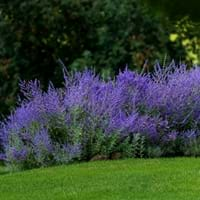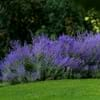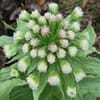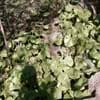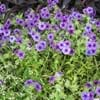Life Span
Perennial
Perennial
Type
Flowering Plants
Grass
Origin
Hybrid origin
North America, Canada, Mexico
Types
Perovskia atriplicifolia LACEY BLUE, Perovskia atriplicifolia ‘Rocketman’
Bigleaf hydrangea, Hortensia, Smooth hydrangea, Oakleaf hydrangea, Annabelle
Number of Varieties
Not Available
Habitat
Not Available
Forest edges, Hillside, Woods
USDA Hardiness Zone
4-9
Not Available
Sunset Zone
2a, 2b, 3a, 3b, 4, 5, 6, 7, 8, 9, 10, 11, 12, 13, 14, 15, 16, 17, 18, 19, 20, 21, 22, 23, 24
1a, 1b, 2a, 2b, 3a, 3b, 4, 5, 6, 7, 8, 9, 10, 11, 14, 15, 16, 17, 18, 19, 20, 21, 22, 23
Habit
Clump-Forming
Upright/Erect
Flower Color
Lavender, Blue Violet
Blue, Dark Purple, Light Purple, Red, White
Flower Color Modifier
Bicolor
Bicolor
Fruit Color
Not Available
Not Available
Leaf Color in Spring
Gray Green, Silver
Green, Light Green, Blue Green, Gray Green
Leaf Color in Summer
Gray Green, Silver
Light Green
Leaf Color in Fall
Gray Green, Silver
Red, Green, Orange, Blue Green, Gray Green, Bronze
Leaf Color in Winter
Silver
Tan, Sandy Brown
Leaf Shape
Grass like
Oblovate
Plant Season
Spring, Summer, Fall
Spring, Summer, Fall, Winter
Sunlight
Full Sun
Full Sun, Partial Sun
Type of Soil
Loam, Sand
Clay, Loam, Sand
The pH of Soil
Neutral, Alkaline
Acidic, Neutral, Alkaline
Soil Drainage
Well drained
Average
Bloom Time
Summer, Late Summer, Early Fall, Fall
Early Summer, Summer, Late Summer
Tolerances
Drought, Salt
Pollution, Soil Compaction
Where to Plant?
Container, Ground, Pot
Container, Ground
How to Plant?
Stem Planting
Seedlings, Stem Planting
Plant Maintenance
Low
Medium
Watering Requirements
Allow soil to be completely dry in between waterings, Do Not over Water
Not Available
In Summer
Lots of watering
Drought Tolerant, Average Water
In Spring
Moderate
Moderate
In Winter
Average Water
Average Water
Soil pH
Neutral, Alkaline
Not Available
Soil Type
Loam, Sand
Not Available
Soil Drainage Capacity
Well drained
Not Available
Sun Exposure
Full Sun
Not Available
Pruning
Prune in early spring, Prune regularly
Remove damaged leaves, Remove dead branches, Remove dead leaves
Fertilizers
All-Purpose Liquid Fertilizer
All-Purpose Liquid Fertilizer
Pests and Diseases
Chlorosis, Red blotch
Red blotch
Plant Tolerance
Drought, Salt
Pollution, Soil Compaction
Flower Petal Number
Single
Single
Fragrant Bark/Stem
Yes
No
Foliage Texture
Fine
Fine
Foliage Sheen
Matte
Not Available
Invasive
No
Not Available
Self-Sowing
No
Not Available
Attracts
Butterflies
Bees, Flies
Allergy
Skin irritation, Toxic
Chest tightness, Diarrhea, Dizziness, Nausea, Vomiting
Aesthetic Uses
Landscape Designing
Not Available
Beauty Benefits
Not Available
Not Available
Edible Uses
Yes
Not Available
Environmental Uses
Insect Repellent
Air purification
Medicinal Uses
Treating fever
Fever, Kidney problems, Urinary tract problems
Part of Plant Used
Flowers, Leaves
Flowers, Root
Other Uses
Culinary use, Oil is used in mosquito repellents, Used as Ornamental plant
Not Available
Used As Indoor Plant
No
Not Available
Used As Outdoor Plant
Yes
Yes
Garden Design
Dried Flower / Everlasting, Cutflower, Feature Plant, Foundation, Mixed Border
Not Available
Botanical Name
Perovskia atriplicifolia
PANICUM virgatum 'Northwind'
Common Name
Longin Russian Sage, Russian Sage
Northwind Switchgrass, Switchgrass
In Hindi
Russian Sage
Hydrangea
In German
russische Sage
Hortensie
In French
sabio ruso
Hortensia
In Spanish
Sage ruso
Hortensia
In Greek
Ρωσική Sage
υδραγεία
In Portuguese
Sábio russo
Hortênsia
In Polish
rosyjski Sage
Hortensja
In Latin
Russian Sage
Hibiscus
Phylum
Magnoliophyta
Not Available
Class
Magnoliopsida
Not Available
Order
Lamiales
Not Available
Family
Lamiaceae
Not Available
Genus
Perovskia
Not Available
Clade
Angiosperms, Asterids, Eudicots
Not Available
Tribe
Mentheae
Not Available
Subfamily
Not Available
Not Available
Number of Species
Not Available
Not Available
Importance of Russian Sage and Northwind Switchgrass
Want to have the most appropriate plant for your garden? You might want to know the importance of Russian Sage and Northwind Switchgrass. Basically, these two plants vary in many aspects. Compare Russian Sage and Northwind Switchgrass as they differ in many characteristics such as their life, care, benefits, facts, etc. Every gardener must at least have the slightest clue about the plants he wants to plant in his garden. Compare their benefits, which differ in many ways like facts and uses. The medicinal use of Russian Sage is Treating fever whereas of Northwind Switchgrass is Fever, Kidney problems and Urinary tract problems. Russian Sage has beauty benefits as follows: Not Available while Northwind Switchgrass has beauty benefits as follows: Not Available.
Compare Facts of Russian Sage vs Northwind Switchgrass
How to choose the best garden plant for your garden depending upon its facts? Here garden plant comparison will help you to solve this query. Compare the facts of Russian Sage vs Northwind Switchgrass and know which one to choose. As garden plants have benefits and other uses, allergy is also a major drawback of plants for some people. Allergic reactions of Russian Sage are Skin irritation and Toxic whereas of Northwind Switchgrass have Chest tightness, Diarrhea, Dizziness, Nausea and Vomiting respectively. Having a fruit bearing plant in your garden can be a plus point of your garden. Russian Sage has no showy fruits and Northwind Switchgrass has showy fruits. Also Russian Sage is not flowering and Northwind Switchgrass is not flowering . You can compare Russian Sage and Northwind Switchgrass facts and facts of other plants too.
